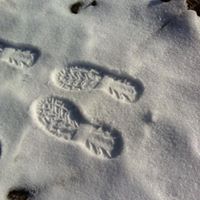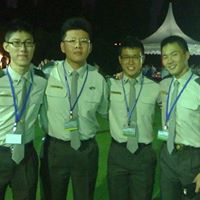Ling O Yang
age ~54
from Saratoga, CA
- Also known as:
-
- Ling Xu Yang
- Ling C Yang
- Ling H Yang
- Ling L Yang
- Lin G Yang
- Bing Yang
- Ling O'Yang
- Yang Bing
- Phone and address:
- 14390 Elva Ave, Saratoga, CA 95070
Ling Yang Phones & Addresses
- 14390 Elva Ave, Saratoga, CA 95070
- Sunnyvale, CA
- San Diego, CA
- Clifton Park, NY
- Morgantown, WV
- Schenectady, NY
Us Patents
-
Method Of Estimating Hold Time Sweep Crack Growth Properties
view source -
US Patent:6405601, Jun 18, 2002
-
Filed:Dec 22, 2000
-
Appl. No.:09/742446
-
Inventors:Ling Yang - Clifton Park NY
-
Assignee:General Electric Company - Schenectady NY
-
International Classification:G01N 1908
-
US Classification:73799
-
Abstract:A method to estimate the crack growth rate of HIPed cast IN718 material with various grain sizes and working environments comprising determining the average grain size diameter and duration of hold time and solving the following equation, whereby N is the number of operating cycles, a is the crack length, da/dN is crack growth rate GS is the average grain size in meters, HT is hold time in seconds, Env is 1 for an air environment, and Env is -1 if a steam environment. The estimates obtained from the transfer function can be used for designing of and predicting the life of cast IN718 components such as manifolds.
-
Large Forging Manufacturing Process
view source -
US Patent:6409853, Jun 25, 2002
-
Filed:Oct 25, 1999
-
Appl. No.:09/426306
-
Inventors:Samuel V. Thamboo - Latham NY
Ling Yang - Niskayuna NY -
Assignee:General Electric Company - Schenectady NY
-
International Classification:C22F 110
-
US Classification:148677, 148410, 148428, 148676
-
Abstract:A process for forging large components of Alloy 718 material so that the components do not exhibit abnormal grain growth includes the steps of: a) providing a billet with an average grain size between ASTM 0 and ASTM 3; b) heating the billet to a temperature of between 1750Â F. and 1800Â F. ; c) upsetting the billet to obtain a component part with a minimum strain of 0. 125 in at least selected areas of the part; d) reheating the component part to a temperature between 1750Â F. and 1800Â F. ; e) upsetting the component part to a final configuration such that said selected areas receive no strains between 0. 01 and 0. 125; f) solution treating the component part at a temperature of between 1725Â F. and 1750Â F. ; and g) aging the component part over predetermined times at different temperatures.
-
Methods And Systems For Evaluating Defects In Metals
view source -
US Patent:6512982, Jan 28, 2003
-
Filed:Dec 20, 2000
-
Appl. No.:09/742667
-
Inventors:Ling Yang - Clifton Park NY
Robert Falsetti - Schenectady NY -
Assignee:General Electric Company - Schenectady NY
-
International Classification:G01N 3120
-
US Classification:702 34, 702 36, 700 30, 707102
-
Abstract:A method and system for evaluating structural defects in metals is provided. In one embodiment, the method recognizes that the acceptability of a given defect is principally determined by the four basic parameters of operating temperature, operating stress, defect area, and defect shape. Ranges are established for each of these four basic parameters, and intermediate values within these ranges are selected to create a series of index value data sets. The method evaluates these index value data sets by calculating a life cycles estimate for each. Using statistical methods, the life cycles results are analyzed to determine the effect each of the four basic parameters has on the life of a component with a defect. Understanding the relationship between these four basic parameters and life cycles enables the method to provide an interpolation algorithm for finding the life cycles for any component having a defect.
-
Method Of Estimating Tensile Properties Of In718 Cast Hiped Components
view source -
US Patent:6539810, Apr 1, 2003
-
Filed:Dec 22, 2000
-
Appl. No.:09/742444
-
Inventors:Ling Yang - Clifton Park NY
-
Assignee:General Electric Company - Schenectady NY
-
International Classification:G01N 308
-
US Classification:73826, 73760, 73789
-
Abstract:A method to estimate the tensile properties of HIPed cast IN718 components at various grain sizes and different operating temperatures by using transfer functions to estimate ultimate tensile strength, yield strength, and elongation.
-
Multiple Alloy Rotor
view source -
US Patent:6962483, Nov 8, 2005
-
Filed:Dec 4, 2003
-
Appl. No.:10/707308
-
Inventors:Swami Ganesh - Clifton Park NY, US
Robin Carl Schwant - Pattersonville NY, US
Peter William Schilke - Brewster MA, US
Ling Yang - Niskayuna NY, US
John Zhiqiang Wang - Greenville SC, US
Robert B. Falsetti - Schenectady NY, US
Francis Alexander Reed - Princetown NY, US -
Assignee:General Electric Company - Schenectady NY
-
International Classification:F01D025/00
-
US Classification:415200, 4152161
-
Abstract:A monolithic rotor comprising first and second rotor regions axially aligned within the monolithic rotor and a transition zone therebetween. The first and second rotor regions are formed of different alloys and the transition zone having a composition that differs from and varies between the first and second rotor regions. The first rotor region is located within a high pressure region of the monolithic rotor and is formed from an alloy chosen from the group consisting of CrMoV low alloy steels, martensitic stainless steels containing about 11 to about 14 weight percent chromium, Fe—Ni alloys, and nickel-base alloys. The second rotor region is located within a low pressure region of the monolithic rotor and is formed from an alloy chosen from the group consisting of NiCrMoV low alloy steels and martensitic stainless steels containing about 11 to about 14 weight percent chromium.
-
Multiple Alloy Rotor And Method Therefor
view source -
US Patent:6971850, Dec 6, 2005
-
Filed:Dec 4, 2003
-
Appl. No.:10/707306
-
Inventors:Swami Ganesh - Clifton Park NY, US
Robin Carl Schwant - Pattersonville NY, US
Ling Yang - Niskayuna NY, US
John Zhiqiang Wang - Greenville SC, US -
Assignee:General Electric Company - Schenectady NY
-
International Classification:F01D005/06
-
US Classification:4152161
-
Abstract:A process for producing a rotor, the rotor formed thereby, as well as turbines in which such a rotor is installed. The rotor is formed by casting an ingot to have first and second regions formed of different alloys that intermix during casting to define a transition zone therebetween. The ingot is forged to yield a rotor forging that contains axially-aligned first and second alloy regions and a transition zone therebetween. The effects of the transition zone can be mitigated by modeling the transition zone and then off-center machining the forging so that the axis of rotation of the machined monolithic rotor is more centrally located with respect to the transition zone.
-
Method Of Processing A Multiple Alloy Rotor
view source -
US Patent:7065872, Jun 27, 2006
-
Filed:Dec 4, 2003
-
Appl. No.:10/707302
-
Inventors:Swami Ganesh - Clifton Park NY, US
Robin Carl Schwant - Pattersonville NY, US
Ling Yang - Niskayuna NY, US
John Zhiqiang Wang - Greenville SC, US
Francis Alexander Reed - Scotia NY, US
Robert V. Falsetti - Schenectady NY, US -
Assignee:General Electric Company - Schenectady NY
-
International Classification:B23P 6/00
-
US Classification:2988912, 2988971, 2940705
-
Abstract:A method of processing a rotor. The rotor is formed by casting an ingot to have first and second regions formed of different alloys that intermix during casting to define a transition zone therebetween. The ingot is forged to yield a rotor forging that contains axially-aligned first and second alloy regions and a transition zone therebetween. A three-dimensional approximation of the transition zone is generated, which can be used to predict the effects of the transition zone on the dynamic performance of a rotor machined from the forging.
-
Process For Producing A Rotor
view source -
US Patent:7546685, Jun 16, 2009
-
Filed:Mar 1, 2005
-
Appl. No.:11/070467
-
Inventors:Swami Ganesh - Clifton Park NY, US
Robin Carl Schwant - Pattersonville NY, US
Ling Yang - Niskayuna NY, US
John Zhiqiang Wang - Greenville SC, US
Francis Alexander Reed - Scotia NY, US
Robert V. Falsetti - Schenectady NY, US -
Assignee:General Electric Company - Schenectady NY
-
International Classification:B23P 15/02
-
US Classification:2988971, 29889, 298892, 298897
-
Abstract:A process for producing a rotor, the rotor formed thereby, as well as turbines in which such a rotor is installed. The rotor is formed by casting an ingot to have first and second regions formed of different alloys that intermix during casting to define a transition zone therebetween. The ingot is forged to yield a rotor forging that contains axially-aligned first and second alloy regions and a transition zone therebetween. The effects of the transition zone can be mitigated by modeling the transition zone and then off-center machining the forging so that the axis of rotation of the machined monolithic rotor is more centrally located with respect to the transition zone.
Name / Title
Company / Classification
Phones & Addresses
HONG KONG RESTAURANT OH, INC
TRUE VAPES INC
Nueva Vista Investments, LC
Investments
Investments
506 Loch Lomond Ct, Milpitas, CA 95035
Lawyers & Attorneys

Ling Yang - Lawyer
view sourceAddress:
Barclays Capital Asia Limited
29032775xx (Office)
29032775xx (Office)
Licenses:
New York - Currently registered 2002
Education:
Notre Dame
License Records
Ling Yang
License #:
05133 - Expired
Category:
Accountants
Issued Date:
Dec 20, 2009
Expiration Date:
Jun 30, 2010
Type:
Certified Public Accountant
Classmates

Cambridge Rindge & La...
view sourceGraduates:
Marianne Szulewski (1971-1975),
David Weston (1982-1986),
Ling Yang (1983-1987),
anthony santoro (1975-1979),
Robert Robert grant (1945-1949)
David Weston (1982-1986),
Ling Yang (1983-1987),
anthony santoro (1975-1979),
Robert Robert grant (1945-1949)
Youtube
Flickr

Ling Ling Yang
view source
Pei Ling Yang
view source
Ling Yang Yang
view source
Mei Ling Yang
view source
Bao Ling Yang
view source
Ling Yang Chang
view source
Ling Yang Feng
view source
Ling Wen Yang
view sourcePlaxo

Ling OU YANG
view sourceProject Manager at KONE
Googleplus

Ling Yang

Ling Yang

Ling Yang

Ling Yang

Ling Yang
Relationship:
Single

Ling Yang

Ling Yang

Ling Yang
Get Report for Ling O Yang from Saratoga, CA, age ~54













